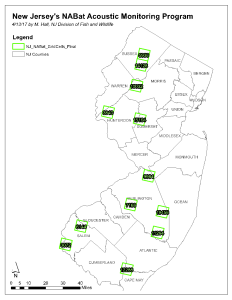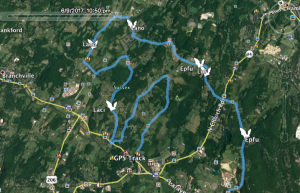Acoustic Monitoring Drives Efforts to Save Bats
by Stephanie Feigin, CWF Wildlife Ecologist

Across the country bat populations continue to decline due to the threat of White Nose Syndrome. Last year, to collect important population data to monitor population trends of New Jersey’s bat species, Conserve Wildlife Foundation of New Jersey (CWF), in partnership with Endangered and Nongame Species Program (ENSP), re-launched their Statewide Mobile Acoustic Surveys with new equipment and protocol. With all the kinks of a revamped project worked out, CWF entered their second year of this project.
Acoustic monitoring is one of the most time-efficient tool available for surveying bats, providing a significant amount of data over longer periods of time. Since most bat species produce calls of a characteristic frequency and pattern, species ID can normally be derived from the calls collected by an acoustic detector. By mounting the detectors to a vehicle, data can also be collected over larger distances and from a range of habitat types. This type of data collection is a passive technique, allowing for minimal disturbance to any species.

In 2010, CWF started a mobile acoustic survey that continued successfully through 2014. With the help of a team of 30+ volunteers, CWF collected large amounts of data from 16+ mobile acoustic routes providing the state with information about New Jersey’s bat populations, habitat choices, and distribution throughout the state.
Previously, the mobile acoustic routes were done with Anabat detectors which collect data in something called, zero crossing which collects incoming echolocation calls by developing a trend line in the time frequency relm of the detector by sampling at discrete points along the calls oscillations between positive and negative values. This provides efficient analysis of representative call parameters, allowing the user to collect sono-graphs of collected data. Although call parameters this type of detector is accurate and effective, the main con of this technique is that the detector is sensitive to the signal with the most intensity, or volume. This can lead to quieter bat calls being missed. Many of the bats of main concern (the myotis bats most affected by WNS) produce high pitched and therefore quieter calls which can be missed with zero-crossing.
With the re-launch of this program, new Pettersson D500x full spectrum detectors were purchased. The primary benefit of full-spectrum analysis comes from the increased accuracy, robustness, and confidence of certain bat calls due to the less-sensitive nature of the detector. Full-spectrum detectors pick up more calls and provide higher quality results. The full spectrum detectors also support new automated processing and classification of bat echolocation sequences allowing for faster processing of the data.

New mobile acoustic routes, randomly generated by the NAbat Working Group, were selected and ground truth-ed and a group of volunteers were trained on the equipment and protocol (Figure 1).
Our team of key staff, CWF lead volunteers and seasonal technicians conducted surveys statewide at 16 separate sites. Each site was given a 2-week window to conduct 2 surveys during the months of May- August with all transects 10-15 miles in length.
This year our team of volunteers ran 16 routes across the state covering over 207.5 miles and collecting over 2000 total quality bat calls. Full analysis of the project data is still to be conducted this fall and will be made public on our website by the winter. Click here for a full report on last year’s data.
Acoustic monitoring has led to new information about New Jersey’s bat species, including their habitat choices and distribution throughout the state. Mobile acoustic surveys are a nationwide concerted effort to catalog basic bat species and abundance information over time, under the NAbat working group.

Figure 1: Map of NJ grid cells for mobile routes


Discover more from Conserve Wildlife Foundation of NJ
Subscribe to get the latest posts sent to your email.
Leave a Comment
On web page https://conservewildlifenj.org/2018/10/05/acoustic-monitoring-drives-efforts-to-save-bats/ you posted a link to read last year’s bat report. The link was to: http://www.conservewildlifenj.org/downloads/cwnj_833.pdf./
Unfortunately, that is a broken link, w8ith no page, let along any report, available there.
Regards,
Kevin Redden
Volunteer, CWF Bald Eagle Project
Thanks for letting us know about the broken link. It’s been fixed.
Comments are closed.